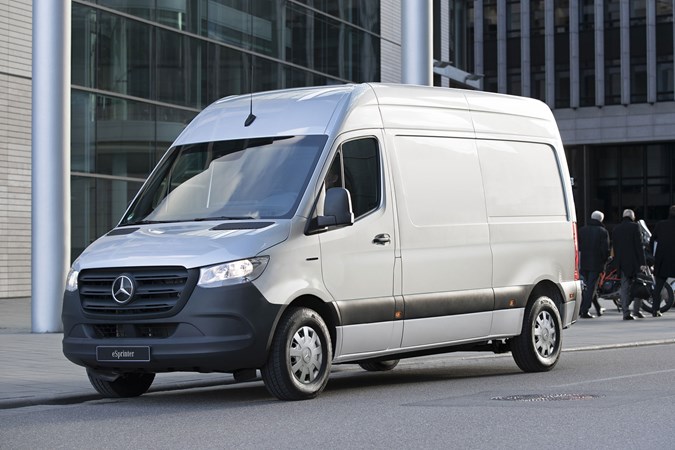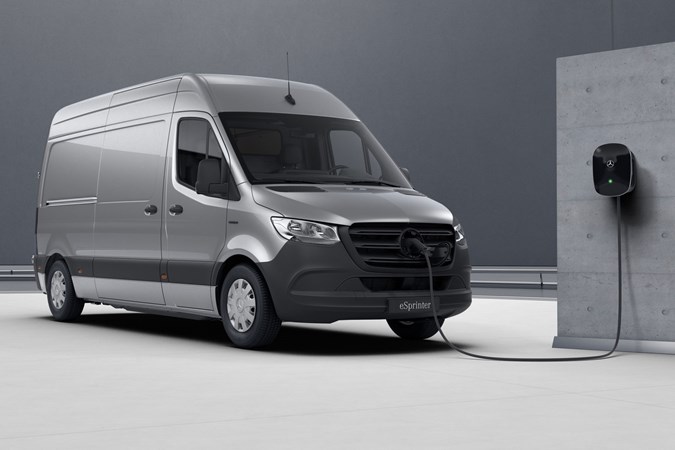UPDATE: we have noe driven this large electric van – read our full Mercedes eSprinter review.
Well, here’s a turn up: the new Mercedes-Benz eSprinter enters the market as the least expensive large electric van you can buy in the UK. Starting at £51,950 before any discount from the government’s Plug-in Van Grant (PIVG), it undercuts the rival Renault Master ZE, despite being based on the most modern, most premium large van platform available.
So, what’s the catch? We’ve got all the info, including UK specification and on sale date – read on to find out if this is all too good to be true.
Lots of standard equipment
You’re unlikely to be disappointed with the kit you get for the money. The eSprinter comes only in the Progressive trim level, and includes all of the following items as standard:
- > Heated driver’s seat (with armrest)
- > Dual passenger bench seat
- > Height and reach adjustable steering wheel
- > Air-conditioning
- > DAB radio
- > Bluetooth
- > Heat-insulating glass
- > Automatic headlights
- > Autonomous emergency braking (Active Brake Assist)
- > Crosswind assistance
- > Driver attention alert
- > Emergency eCall system
- > Full bulkhead / partition
- > Wood-lined load floor
- > Rear doors that open 270 degrees
- > Thatcham Category 1 alarm system
- > Remote locking with double locks
- > Mercedes Pro Connect – which not only delivers vehicle status updates straight to your mobile but also includes vehicle tracking, theft warning and geo-fencing options, free for the first two years
Mercedes Pro Connect controls the pre-conditioning system as well, meaning you can use it to pre-set the temperature inside the cab of the van while it’s plugged in and charging, saving you time and extending the driving range. Plus there are a number of fleet-friendly features, including real-time route mapping and vehicle management, driving style analysis, and digital driving records.
The eSprinter’s battery system comes with an eight-year / 160,000km (100,000-mile) warranty, that ensures it should still be operating at 70% capacity or more over that time. The rest of the van is covered by Mercedes’ usual three-year unlimited mileage warranty.
What’s the driving range of the eSprinter?
Ah, now we’re getting to the potential issues here. According to the latest WLTP standards, the eSprinter has a maximum driving range of 96 miles per charge – and that’s on vans with an 80km/h speed limiter, that’s just under 50mph.
With a 120km/h speed limiter – just under 75mph – the eSprinter’s official range falls to 83 miles per charge.

Compare that to the Renault Master ZE, which has been on sale since 2018. This claims a 124-mile WLTP driving range. However, the Master ZE’s battery pack is much smaller than the eSprinter’s – 33kWh (kilowatt hour) rather than 55kWh – and Renault’s own range predictions suggest you’re more likely to see 75 miles in summer driving and 50 miles in winter driving.
As you can tell, electric van range is a bit of a confusing issue at this time. Mercedes claims that its own data – collected anonymously via the 1.6 million journeys completed using its EQ Ready app, which is designed to help customers find out if they could live with an electric vehicle – shows that the average daily distance for vans across Europe is 60 miles.
The eSprinter should certainly cope with that.
What’s the charging time of the eSprinter?
Mercedes also claws some ground back against the Master ZE here, as two versions of the van are offered, one with a 20kW DC charger built in and a slightly more expensive model with an 80kW DC charger built in.
The 20kW variant can charge from 10% battery to 80% battery in 120 minutes (three hours), while the 80kW eSprinter will do the same in just 30 minutes – assuming access to a suitably powerful charging point. The Renault’s fastest charging time is six hours.
The eSprinter also includes 7.4kW AC charging, suitable for use with a domestic wallbox charger, and this gives a full 0-100% charge in eight hours. You can also use a three-pin plug, but you’ll need plenty of time for that…
How powerful is it?
The eSprinter is based on the front-wheel drive (FWD) Mercedes Sprinter, and in place of the usual diesel engine there’s an 85kW electric motor – equivalent to 116hp. This too gives the Master ZE a bit of a hiding, as the Renault uses a 57kW motor (just 77hp).
The Mercedes also produces substantially more torque: 295Nm to the Renault’s 225Nm. However, the basic van weighs considerably more; the eSprinter’s unladen weight is 2,726kg, while an equivalent Master ZE weighs just 2,080kg.
What’s the payload of the Mercedes eSprinter?
As you can probably guess, the weight of the eSprinter has a substantial impact on its payload – with a maximum gross vehicle weight (GVW) of 3,500kg (3.5 tonnes), it has a payload rating of just 774kg.
Even the smaller Mercedes-Benz eVito will handle more than that, so the eSprinter is very much a machine for bulky but relatively lightweight goods; couriers and delivery firms should be fine.
But to be clear, the maximum payload available from a Master ZE panel van is 1,490kg, nearly double the eSprinter’s payload. An equivalently sized Master ZE panel van will carry 1,420kg.
Both vans mount their battery packs under the load floor, so there’s no reduction in cargo volume.
Is there more one size of eSprinter?
Another area where the eSprinter loses out to the Master ZE is variety. Mercedes is selling it in a single L2H2 panel van body size – whereas the Renault is available in a wide selection of sizes and conversions, with Luton bodies, low loaders, platform cabs and chassis cabs all in the pricelist.

However, Mercedes says that the vast majority of Sprinters sold in the UK are L2H2 models, so the eSprinter should suit its target customers. And presumably the lack of variation helps keep pricing low.
See our dedicated Mercedes Sprinter dimension page for full L2H2 details.
The only difference between eSprinter models right now is therefore the charging capability.
Is the eSprinter good value?
It looks very good value to us. Just to put that basic £51,995 eSprinter asking price into perspective, the equivalent figure for the cheapest Master ZE is £60,000, or around £52,000 with the UK government Plug-in Van Grant – which means the eSprinter costs less without the PiVG than the Master ZE does with it.
With potential PiVG savings of £8,000 on the eSprinter’s price, plus eligibility for the Transport for London van scrappage scheme, some buyers will be able to save in the region of £17,500 on that £51,995 figure.
Want the faster 80kW charging capability? That version of the eSprinter costs £52,475 – again that’s before any grant or other discounts.
Also read:
>> Our Mercedes-Benz eSprinter review
>> The Parkers guide to electric vans
>> The best electric vans you can buy now
>> Our main Mercedes-Benz Sprinter review
>> Mercedes-Benz eSprinter prototype drive
Just so you know, we may receive a commission or other compensation from the links on this website - read why you should trust us.






